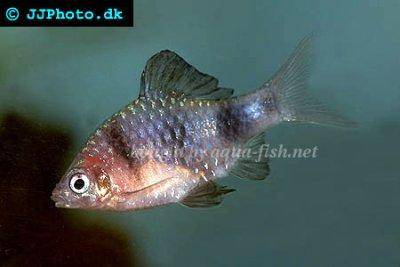Ruby barb - Puntius nigrofasciatus
Scientific name: Puntius nigrofasciatus
Common name: Ruby barb
Family: Cyprinidae
Usual size in fish tanks: 5 - 6 cm (1.97 - 2.36 inch)
014
Recommended pH range for the species: 5.5 - 7
Recommended water hardness (dGH): 4 - 12°N (71.43 - 214.29ppm)
0°C 32°F30°C 86°F
Recommended temperature: 20 - 26 °C (68 - 78.8°F)
The way how these fish reproduce: Spawning
Where the species comes from: Sri Lanka
Temperament to its own species: peaceful
Temperament toward other fish species: peaceful
Usual place in the tank: Middle levels
Food and feeding
Ruby barbs are omnivores and readily accept a variety of commercial aquarium foods such as high-quality flakes and micro pellets. To support their vibrant coloration and overall health, it's beneficial to supplement their diet with live or frozen foods such as bloodworms, daphnia, or brine shrimp at least once or twice a week. Fresh blanched vegetables like zucchini or spinach can also be offered occasionally.
Origin
Puntius nigrofasciatus is native to Sri Lanka, where it inhabits cool, slow-flowing hill streams and river basins rich in vegetation. These environments often feature shaded areas with sandy or rocky substrates, which help mimic their natural habitat in captivity.
Sexing
Sexual dimorphism is noticeable in adult ruby barbs. Males are typically more vibrantly colored with a reddish hue, especially on their body and fins, and they often display a darker overall tone. Females are generally paler with a rounder, fuller body shape, particularly when carrying eggs. The males may also exhibit red highlights on their anal and pelvic fins.
Breeding
Ruby barbs are egg-scattering spawners that do not exhibit parental care. To encourage breeding, set up a separate breeding tank with soft, slightly acidic water and a temperature around 24–26 °C (75–79 °F). Provide fine-leaved plants such as Java moss or use spawning mops to protect the eggs from being eaten. After spawning, which often occurs in the early morning, remove the adult fish immediately. Eggs usually hatch within 24–36 hours, and fry will become free-swimming after another 3–4 days. Feed the fry infusoria or liquid fry food initially, then transition to finely crushed flakes or microworms.
Lifespan
Under proper care and stable conditions, ruby barbs can live up to 5 years in a home aquarium.
Short description
The ruby barb (Puntius nigrofasciatus) is a peaceful, active schooling fish that thrives in groups of six or more. Keeping them in a group not only enhances their natural behavior but also helps reduce stress and encourages vibrant coloration in males. These fish prefer the middle levels of the aquarium and enjoy plenty of open swimming space. A well-maintained tank with gentle filtration, stable water parameters, and subdued lighting will closely resemble their natural environment. The species was formerly known under the synonym Barbus nigrofasciatus.
Suitable tankmates
Ruby barbs are peaceful and do well in a community tank with other non-aggressive species. Ideal tankmates include:
Recommended plants
Ruby barbs appreciate a planted aquarium, which provides shelter, reduces stress, and supports spawning. Suitable plant species include:
- Java fern (Microsorium pteropus)
- Java moss (Vesicularia dubyana)
- Cryptocoryne wendtii
- Anubias barteri
- Limnophila sessiliflora
Pictures
Bought by aqua-fish.net from jjphoto.dk.




 Bala
Bala  Tinfoil
Tinfoil  Congo
Congo  Blue-barred
Blue-barred  African
African  Butterfly
Butterfly  Olivegreen
Olivegreen  Morse
Morse  Jerdon’s
Jerdon’s  Mosquito
Mosquito  Dwarf
Dwarf  Goldfish
Goldfish  Penguin
Penguin  Siamese
Siamese  Koi
Koi  Pearl
Pearl  Glowlight
Glowlight  Crossbanded
Crossbanded  Yoma
Yoma  Orange
Orange  Dwarf
Dwarf  Zebra
Zebra  Rose
Rose  Scarlet
Scarlet  Red
Red  Arulius
Arulius  Bengal
Bengal  Tiger
Tiger  Malabar
Malabar  Queen
Queen  Hora
Hora  False
False  Redtail
Redtail  Flying
Flying  Labeo
Labeo  Garra
Garra  Black
Black  Purple
Purple  Burmese
Burmese  Isok
Isok  Rosy
Rosy  Two
Two  Denison
Denison  Clown
Clown  Melon
Melon  Black-spot
Black-spot  Golden
Golden  T-Barb
T-Barb  Checkered
Checkered  Fiveband
Fiveband  Dwarf
Dwarf  Rhomb
Rhomb  Gold
Gold  Golden
Golden  Tambraparni
Tambraparni  Tiger
Tiger  Cherry
Cherry  Brittan’s
Brittan’s  Greater
Greater  Hi-spot
Hi-spot  Long-band
Long-band  Twospot
Twospot  Reticulate
Reticulate  Cherry
Cherry  White
White  Lambchop
Lambchop  Harlequin
Harlequin